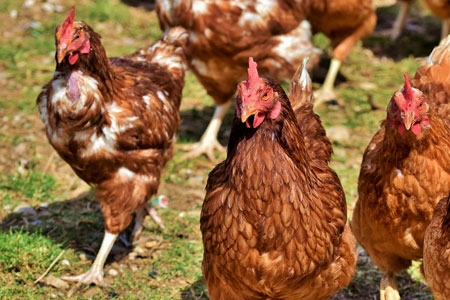
Heating is energy intensive. So chickens don’t usually thaw at times when they need food energy elsewhere. For example, spring roosters use energy for fertility and hens use energy to lay eggs and hatch chicks. Chickens in cold weather need energy to keep warm. During molt, feeders that go toward such pursuits instead head toward producing feathers. The faster the shed sheds, the faster the chickens can return to business as usual. Here are some ways you can help your chicken by molting.
Protein boost
Feathers are 85% protein. Therefore, chicken needs more dietary protein during the molting process. Otherwise, new feathers may be slow to replace the fallen ones, a condition known as rigid moulting. Furthermore, the newly emerging feathers may be poorly formed.
One way to increase protein is to switch from the normal serving of 16% to 20%. If the high protein ration is not available, you can substitute the farmer’s ration.
In fact, when a hen drops in after a group of chicks have hatched, I feed her the same raw ration she feeds her chicks. The hen won’t start laying again yet, anyway, and she can use the extra protein to regrow her feathers.
When a chicken is about to molt in the fall, its feathers take on a duller appearance. This is the time to start moving to higher protein portions. A gradual transition is important to avoid digestive discomfort that could make molting more difficult.
Gradually mix the higher servings of protein into the new ration over the course of about a week, until the chicken has received the full 20% protein ration. When molting is complete and the chicken resumes laying, gradually move up to the 16% protein content.
animal protein
Compared to the protein found in grains, animal protein is richer in amino acids that chicken needs during molting. So a little supplemental animal protein will help your chickens through molting, as well as improve the plumage of show birds. Animal protein may come from any of these sources:
- Scrambled or hard-cooked eggs
- Dried mealworms
- Sprouted alfalfa or sesame seeds
- fish meal or fish
- High quality cat food
- Bird dropping food from a pet store
While molting, avoid other types of treats. Feeding chickens may not be getting enough protein and other nutrients needed for feather development.
Reduce stress
In addition to being energy intensive, molting is stressful. You can help chickens through molting by taking measures to reduce additional stress in their lives.
Avoid unnecessary handling during molting, when chickens have fewer guard feathers and are therefore more sensitive to touch. Also, make sure they have plenty of room to move around without rubbing against each other, as well as outside shade to protect them from sunburn.
Feather picking
Feathers consist largely of protein. And the fledgling feathers are full of blood, which is another good protein source. So it makes sense that a hen that is not receiving enough protein will want to eat the feathers.
The newly emerging plumage, or pin feathers, therefore attract picking. The areas around the tail and along the back are particularly vulnerable.
While moulting, watch as it is plucked and handled before it descends into a full-blown case of cannibalism. Make sure to increase your protein diet. If necessary, separate the more aggressive picker from the herd.
Keratin shafts
Each newly emerging feather is covered in a thin sheath of keratin that separates from the pin feather when the chick starts. You may not notice these sheaths as they quickly scratch with the beak or claw. Exceptions are on the chicken’s head and neck, which are the places the bird can’t reach.
Your chicken will appreciate your help in removing hard-to-reach keratin sheaths. Use your fingers to gently scrape the sheaths in the direction they grow, or gently rub the feathers with a damp cloth. Another way to remove keratin shafts is to lightly spray them with a mist of warm water and then gently wipe them off with a dry cloth.
And that’s today’s news from Cackle Coop.
Gail Damero is the author of Storey’s Guide to Raising Chicken.

